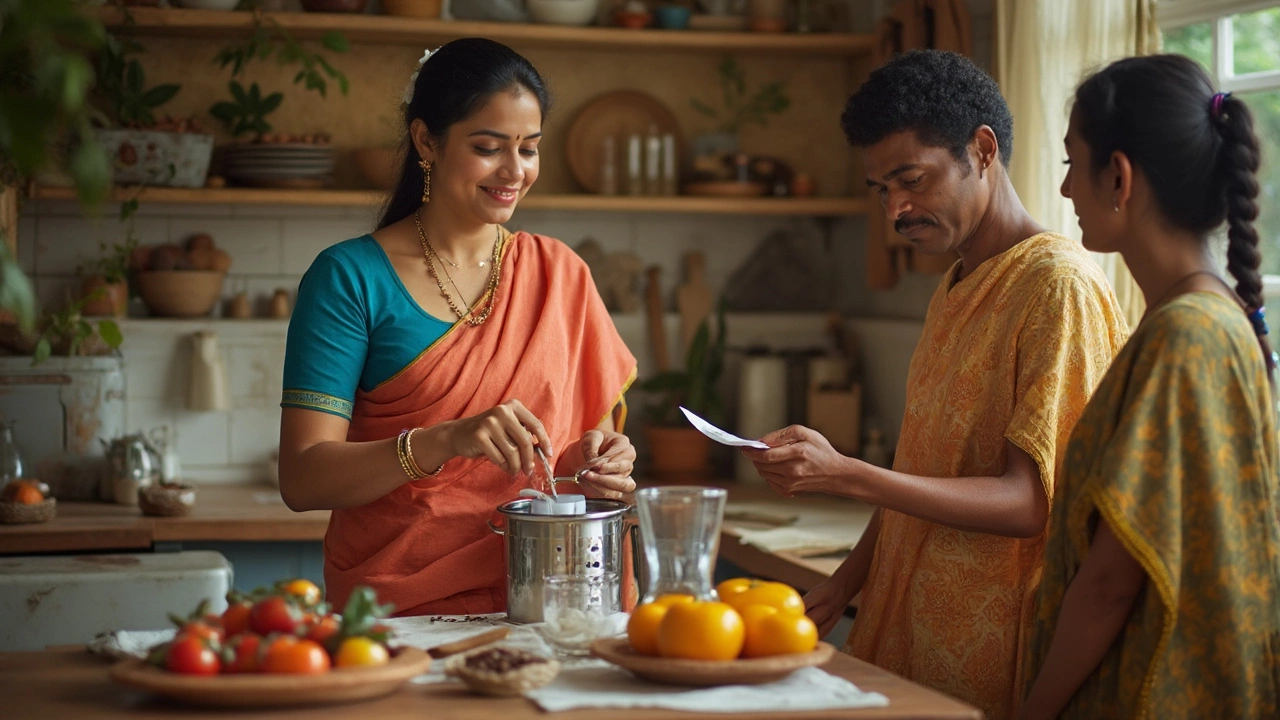Did you know that up to half of all foreign visitors in India will see their trip ruined by Delhi belly? It’s a notorious souvenir, right up there with fridge magnets – only nobody wants it. One dodgy samosa, or a couple of ice cubes in your drink, and you're spending way too much of your adventure racing to the loo. It’s not just an inconvenience; it can knock you flat for days, make you miss out on experiences, and derail your plans. The thing is, Delhi belly isn’t just a myth or a rite of passage—it’s real, it’s common, but it’s also avoidable for most travellers when you know what you’re doing.
Understanding What Causes Delhi Belly
Let’s get honest: What people call “Delhi belly” is really a nasty bout of traveler's diarrhea, often caused by bacteria like E. coli, Salmonella, or parasites that get into your system through contaminated food and water. Indian food gets wrongly blamed for being 'too spicy,' but it’s not the spice—it’s the microbes. That's why locals, whose guts are used to those germs, don't get sick nearly as often. You, on the other hand, are blissfully microbe-naive, and your stomach is soft as pudding compared to theirs.
Different studies have found that about 40% to 70% of travellers to India experience gastrointestinal upsets in their first week. Humidity, heat, and differing hygiene standards set the stage for bacteria to flourish at street stalls or even in hotel buffets if standards slip. It’s not about how fancy the restaurant looks—the enemy is invisible.
Culprits are everywhere: unwashed fruit, uncooked veggies, street food that sits too long, and tap water. Even “washed salads” in high-end places can be risky. And let’s not forget ice cubes—often made from non-filtered water.
Here’s the nasty chorus line that causes Delhi belly:
- Contaminated water (even traces in your cup or on plates can trigger it)
- Uncooked or undercooked foods (including salsas, dressings, and chutneys)
- Street vendor snacks exposed to dust and heat for hours
- Shellfish, especially in places far from the coast, are minefields
- Dairy, unless you see it boiled, can harbour unwelcome bacteria
Weird fact? Even brushing your teeth with tap water or chewing on ice can get you squatting in agony. Worldwide, the CDC’s stats warn: up to 70% of all travel sickness in developing regions is due to fecal–oral transmission. In India, that usually means eating food handled by someone who didn’t wash their hands properly, or sipping water that’s not purified.
Now, this isn’t a call to hide in your hotel eating toast—just to build some street smarts.

Practical Tips to Avoid Stomach Trouble in India
Maybe you’re thinking, “Try everything, experience it all!” That’s the spirit, but you do want to enjoy your holiday from outside the bathroom. So, what actually works? I can guarantee, based on countless chats with seasoned travellers and doctors, it’s a lot about preparation and a pinch of vigilance.
- Choose water carefully. Always stick to factory-sealed bottles. Check the seal—sometimes bottles get refilled with tap water and resold. In many regions, tap water isn’t safe for drinking or brushing your teeth. If you want to go greener, reliable water filters or UV purification gadgets are genius—they zap bacteria and viruses in under a minute.
- Watch out for ice. No restaurant owner will admit it, but a shocking amount of ice is made from dodgy water. Say “no ice” clearly, even in upmarket places.
- Go for cooked food. Freshly steamed, grilled, or fried food is safest. High heat kills bacteria, so piping-hot snacks right from the tawa (griddle) or deep fryer are your best mates.
- Avoid uncooked salads and fruit unless you peel it yourself. Bananas and oranges? Safest. Sliced fruit on a tray by the road? Think again—lots of hands, dust, and flies have visited first.
- Be picky about street food. Famous stalls with big crowds and hot turnover are safer than ones with tired snacks sitting for hours. Street food is delicious—just pick busy places, and watch your snack finish cooking before it comes to you.
- Hand sanitiser is a lifesaver. Use it after touching money, before eating, and after handling shared surfaces. Pack it, use it, love it.
- Wash your hands whenever possible. Soap and water beat sanitiser when you can get them—especially before eating.
- Check cutlery and dishes. Clean isn’t the same as “wiped with a slightly damp cloth.” If it looks questionable, give it a quick clean with your sanitiser or ask for another.
- Avoid dairy unless boiled. Lassi is brilliant if it’s made with boiled milk and served in a proper cafe—not from a jug sitting in the heat.
- Trust your gut!!! If something feels off—smell, look, or just that deep-down traveller instinct—skip it. There’s always another meal ahead.
One interesting survey found that people who stuck strictly to bottled water and freshly cooked food had 70% less chance of falling sick than those who took their chances. Probiotics can also help (beginning them a couple of weeks pre-trip), building up your gut bacteria to battle the foreign bugs. Yakult or similar drinks are sold widely in India now, so you can keep topping up.
| Common Source | Risk Level | What to Look For |
|---|---|---|
| Street food (freshly fried) | Medium | Hot, served straight from pan, busy stall |
| Bottled Water | Low | Unbroken seal, major brands |
| Unpeeled fruit | High | Dusted, possibly handled by many |
| Filter/boiled water | Low | Made in your presence, boiling visible |
| Cold buffets | High | Food sitting out, cold plates |
One thing you’ll notice is that locals have no qualms about eating everything under the sun. Their immune systems are practically superheroes. You aren’t them. Don’t try to prove yourself by copying every bite. Save your risk-taking spirit for bungee jumping or haggling at the bazaar.

Dealing with Delhi Belly: What if You Get Sick Anyway?
Let’s say you did everything right, but that famous Delhi jalebi (sweet) or a mug of chai at a hole-in-the-wall joint still lands you in deep trouble. It happens to the best of us; don’t get mad, don’t panic. The trick is to know what to do, so you bounce back fast and don’t ruin your holiday.
First thing—hydration is your best friend. Your main worry now isn’t the toilet runs; it’s losing fluids and electrolytes. Oral rehydration solution (ORS) is widely available at chemists and newsagents all across India. It’s a mix of salts and sugar to keep your body balanced while you recover. Mix a packet in a litre of clean water and sip it through the day. If you can’t get ORS, add a teaspoon of salt and six of sugar to a litre of safe water. Your body will thank you.
- Take it easy on solid food—simple stuff like rice, bananas, or toast is gentler.
- Avoid all dairy for now, and skip the spicy curries. Your gut will not thank you for more heat while it’s already inflamed.
- Rest a bit. Even if your travel plan is packed, you’ll have a better holiday if you give your gut one day off.
- If diarrhoea is severe (lasting more than 48 hours), or if there’s blood, persistent vomiting, or dizziness, see a doctor straight away. Many local clinics have English-speaking staff and loads of experience with foreigners.
Most cases ease in a day or two, especially if you take care of hydration. You can carry over-the-counter remedies like loperamide, but always use them cautiously—sometimes, you really need to let your body flush the bacteria out.
A little secret: many expats, guides, and long-term visitors in India travel with a tiny emergency kit. Here’s a simple one to copy:
- Betadine or Dettol wipes for cleaning minor wounds or your hands
- Hand sanitiser gel
- Motion sickness tablets, just in case
- ORS sachets (they weigh nothing)
- Small pack of tissues or toilet paper (rare in many public loos)
- Travel antibiotics for severe cases—ask your GP beforehand
Most pharmacies in big Indian cities are staffed by knowledgeable people who can help if you start to feel rough. Show them your symptoms, and don’t feel embarrassed—Delhi belly is almost a tourist club. You won’t be the first, or the last, to walk in clutching your stomach.
One word about local remedies: a lot of folks will suggest ginger tea, cumin seeds, or even plain yogurt. These can soothe mild cases, but they’re no substitute for ORS and good hydration if things get bad. If in doubt, trust your body—if you’re getting weaker, don’t tough it out. See a doctor.
And when you recover, ease back into fancier food slowly. Enjoy a dosa, sip some chai, and remember: surviving Delhi belly is a badge of honour—just one that’s better avoided if you can help it.
